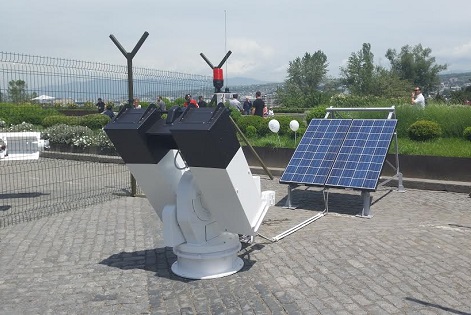Made in Georgia: Anti-hail device among Independence Day exhibits

An anti-hail device developed by Georgia’s State Military Scientific Centre Delta is among the exhibits on display on Rustaveli Ave in Tbilisi to mark Georgia’s Independence Day today.
Delta Director General Ucha Dzodzuashvili told Agenda.ge rockets would be attached to the device and the anti-hail system would be completed in a couple of days.
The system was developed as a way to reduce damage to crops caused by hail by up to 95 percent.
The anti-hail net system included a rocket launching device, solar panel, grounding and security systems installed at each launching site. The launching device will carry 24 anti-hail rockets, which can be aimed in any direction and fired.
Authorities said the aim of hail suppression works were to dramatically reduce crop damage caused by hail storms, reduce the size of the hail or change them into raindrops by dispersing a special reagent (silver iodide) in the clouds before the hailstones are formed.
The Anti-Hail System consists of:
- A weather radar with special software;
- A central control station, located in Tbilisi;
- An automated fire control system;
- Rocket launching sites;
- Rocket launching devices - SD-56; and
- Anti-hail rockets.
How it works:
The weather radar is a C-band, dual polarized Doppler radar, which generates data to predict hail-producing thunderstorms. Information gathered from the radar, plus the databases of hail-consisting clouds, are used by the software, using specific algorithms, to determine areas where the silver iodide reagent needs to be dispersed.
The central control station is an off-site facility where information from the weather radar and rocket launching sites are gathered, processed and where the automatic fire control system is placed. The automatic fire control system receives data and uses this information to define the optimal launching site and determine the number of rockets needed, then sends this information to the rocket launching devices.
Dzodzuashvili said the central control station was already fully functional.
The anti-hail rocket is an unguided, 60mm rocket, which has the capacity to carry 50-70g of silver iodide reagent. This compound will be dispersed at altitudes of 2.5-4.5km above ground for 30-35 seconds. The estimated number of rockets needed in a 12-month period is 5,000 units.
Hail has always been a major issue for people in Kakheti, top wine-making region in Eastern Georgia. Every year a large portion of the agricultural sector, particularly grapes, are damaged beyond repair by hail, leaving farmers with no crops, which was why this anti-hail device was crucial for the country.
Click here to see what other machines and vehicles Delta presented to the public today.
 Tweet
Tweet  Share
Share